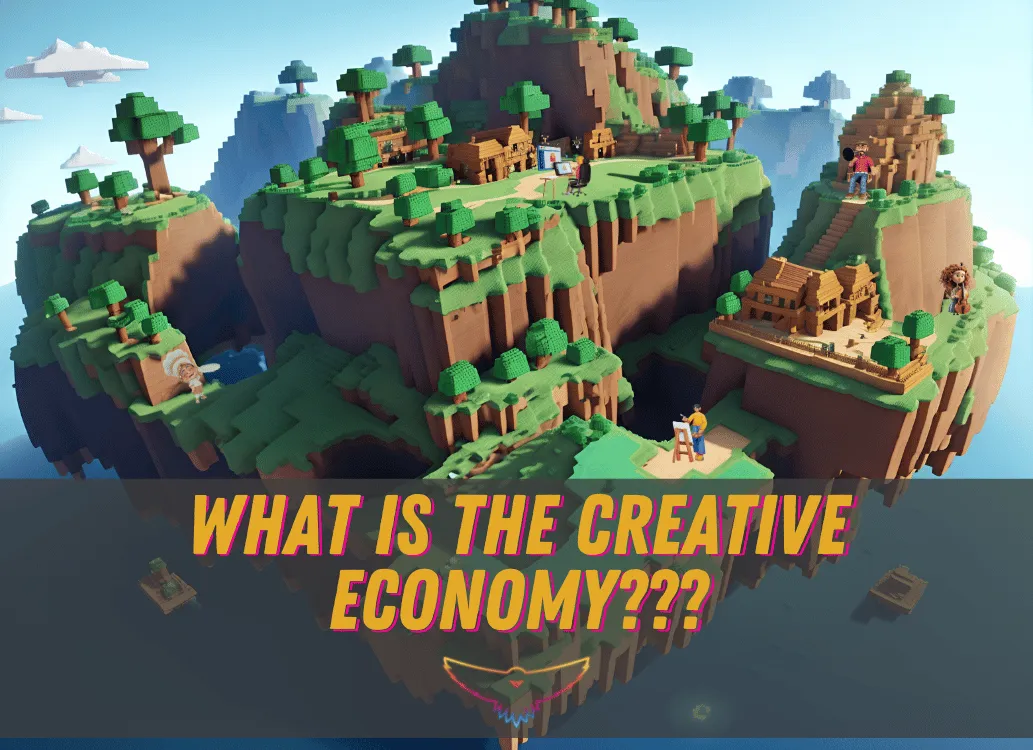The Definition of the Creative Economy
The creative economy is the primary driver and motivation behind the Nomadx Foundation. However, despite being a commonly used phrase, it is generally loosely defined. It refers to an economic system that relies on the generation and exploitation of creative ideas, knowledge, and intellectual property. This system encompasses a wide range of industries and activities that are based on human creativity and imagination. The creative economy is seen as a driver of economic growth, innovation, and competitiveness. In this article, we will explore the different definitions of the creative economy and understand its significance in today's global landscape.
"There is no doubt that creativity is the most important human resource of all. Without creativity, there would be no progress, and we would be forever repeating the same patterns."
-Edward De Bono
What is the Creative Economy?
The creative economy is where creativity, culture, economics, and technology meet. It includes sectors that rely on intellectual property, offering opportunities for wealth and job growth by utilizing and promoting cultural and creative assets. Currently, the Nomadx Foundation identifies eight key pillars of this economy: Art, Architecture, Content, Design, Gastronomy, Literature, Music, and Programming. Each pillar is further divided into specific practices that have their distinct economic products. The essence of the creative economy lies in valuing innovation, cultural expression, and creativity as engines for economic progress.
As described by the United Nations Conference on Trade and Development (UNCTAD), the creative economy is driven by people and organizations using their creativity to fuel job opportunities, revenue, and community enrichment. This means industries that center around creativity are essential for creating value.
In sum, the Nomadx Foundation categorizes the creative economy into eight primary sectors. These areas not only boost the economy but also add to cultural variety and societal well-being.
Art: Acting, dance, photography, graffiti, tattooing, and painting are some forms of creative expression within the first pillar of the creative economy. Art is a visual representation of expression, typically involving imagination made tangible. Its purpose is to communicate, capture, or evoke human emotion. Artists are known for their abstract and non-linear approach to decoding emotion and messaging. They explore and analyze every aspect of humanity and its boundaries, embracing new technologies and mediums of communication.
In the realm of creative entrepreneurship, the expressive nature of art is transformed into sellable or contractable products. This marks the fundamental distinction between an artist who solely seeks to express themselves and a creative entrepreneur who produces artistic products for commercial purposes.
Architecture: Architecture deals with the design, planning, and construction of structures and environments, with a focus on both aesthetics and functionality. Architects are responsible for designing the structure, inner workings, experiences, furnishings, and/or environmental effects of a given space. It encompasses various styles and periods, as well as the practical and theoretical aspects of design and construction. The field of architecture involves the planning and design of both interior and exterior spaces, using a range of materials and construction techniques. It also takes into account factors such as accessibility, sustainability, and the cultural and historical context in which a building is being constructed. Ultimately, architecture is the art and science of creating structures that not only serve a practical purpose but also inspire and influence the people who interact with them.
Content: Content refers to any purely nonmusical audio, visual, or audio-visual product generated for the purpose of entertainment, orientation, persuasion, motivation, or message transmission through traditional media or other technological mediums. The purpose of content is usually clear and generally follows an established set of rules, narrative, or mission. The term “content” derives from the function of a container; thus, content typically consists of several parts that are metaphorically “contained” within a single product. This can include audio tracks, videos, scripts, and purposeful dynamics.
Content has incorporated many traditional creative practices, such as film and television, and grouped them with other production practices like digital shorts and vertical videos due to the dynamic nature of the mediums and formats of consumption.
Design: Design is the purpose, plan, and specific proposal of how something should be for a specific goal or task. Be it for aesthetic, functional, or ergonomic reasons. Design creates before the fabrication of an object, space, message, experience, or product. It involves making decisions about form, function, and aesthetics, as well as the choice of materials, colors, and other visual elements.
Design can complement various fields, including architecture, engineering, and product design, among others. In each field, design is used to solve problems and create functional, sometimes visually appealing, and often innovative solutions. Design often involves collaboration, research, and iteration, to create something functional and aesthetically pleasing to the intended audience. Design is conceived around functionality and purpose, the fundamental difference between Art and Design.
Gastronomy: The creative entrepreneur who focuses on gastronomy creates, applies, and defines everything related to the preparation, development, and experience of foods and beverages. This includes their history, cultural significance, and culinary techniques. Gastronomy encompasses the entire dining experience, from the selection and preparation of food to its presentation, as well as the social and cultural context in which food is consumed. It requires an understanding of ingredients, flavors, and nutrition, as well as the history, traditions, and techniques associated with different cuisines. Gastronomy also considers the sensory aspects of dining, such as taste, smell, and texture, and how these elements combine to create a complete experience. It is a multidisciplinary field that draws on knowledge from various areas, including culinary arts, food science, nutrition, sociology, and cultural studies.
This type of creative entrepreneur not only creates a product but also often serves as a catalyst for transforming existing food products or processes. These products become more than just nourishment; they become vehicles that provide consumers with designed and purposeful journeys.
Literature: Literature is often regarded as an artistic expression that relies on written language. However, its definition can be expanded to include any use of words that conveys a message or emotion in an organized manner. It encompasses a wide range of traditional genres, such as fiction, poetry, drama, and non-fiction, and can be presented in various styles, forms, and structures. Literature frequently reflects and comments on society, human behavior, and the human condition, serving to entertain, educate, and challenge its readers. For thousands of years, literature has played a central role in shaping our thoughts, emotions, and beliefs, and continues to be a vital aspect of human culture.
In terms of creative entrepreneurship, literature involves the utilization of language to create a creative product. It combines the conceptual elements of art with the objective aspects of design, resulting in a product crafted through written language. Literature can be experienced through reading, performance, or other forms of interpretation or adaptation.
Music: The definition of music, in its most basic form, is the organization of sounds and silences. The structure of silences and sounds can transmit messages, emotions, sequences, and codes. Music can be enjoyed purely for leisure or as an enhancement to other products or services. Music is an art form and cultural activity that utilizes sound as its medium. General definitions of music include common elements such as pitch (which governs melody and harmony), rhythm (including tempo, meter, and articulation), dynamics (loudness and softness), and the sonic qualities of timbre and texture (sometimes referred to as the “color” of a musical sound). Different styles or genres of music may emphasize, de-emphasize, or omit some of these elements. Music is performed using various instruments (traditional, electronic, and alternative) and vocal techniques that range from singing to rapping. There are instrumental pieces, vocal pieces without instrumental accompaniment, and pieces that combine singing and instruments.
Programming: Programming is the process of developing digital or electronic technology through the use of coding or writing digital instructions in order to achieve a specific goal. It involves the design and coding of computer software applications and systems, using a programming language to write code that can be interpreted and executed by a computer. Programming languages such as Python, Java, C++, and others provide a set of instructions and commands that programmers can use to create software that performs specific tasks. Successful programming requires problem-solving skills, attention to detail, and a strong understanding of algorithms and data structures. The end result of programming is typically a software application or system that can automate tasks, store and process data, or provide a user interface.
Programming can be considered a creative art form, as it involves the conceptualization and organization of ideas in the mind of the programmer, similar to composing music, but with a specific purpose, like design.
Evolving Definitions
It is important to note that the definition of the creative economy is not fixed and continues to evolve. Americans for the Arts defines the creative economy as being based on people's use of their creative imagination to increase the value of an idea[^2^]. This definition emphasizes the role of creativity in enhancing the value of products, services, and experiences. The creative economy is an evolving concept that changes as technology and culture change potentials, customs, and needs.
Moreover, some observers argue that creativity is the primary source of economic growth and that the creative economy is a key driver of innovation and competitiveness[^3^]. They believe that creativity fosters new ideas, products, and inventions that lead to increased productivity and economic prosperity.
The "Orange Economy"
The United Nations published a report on the "orange economy," which specifically refers to the creative economy in Latin America and the Caribbean[^4^]. This report highlights the potential of the creative economy to generate economic growth, employment, and trade in these regions.
The "orange economy" recognizes the unique cultural assets and creative industries present in Latin America and the Caribbean. It emphasizes the economic value of creative expression and cultural heritage, aiming to leverage these assets for sustainable development.
IMPORTANCE AND IMPACT
The creative economy plays a significant role in today's global landscape. Its importance can be seen through various dimensions:
1. Economic Development: The creative economy is a key driver of economic growth, creating jobs and providing income for individuals and businesses. It is an invaluable source of knowledge, and understanding of the world around us, and is a cornerstone of many scientific and technological breakthroughs. Jobs are an integral part of any local economic development strategy, and self-employment that is created through creative entrepreneurship and supported locally is generally lifelong.
2. Innovation and Competitiveness: Creativity and innovation go hand in hand. The creative economy fosters innovation by pushing the boundaries of traditional industries and developing groundbreaking ideas and technologies. This, in turn, enhances competitiveness at both national and international levels.
3. Cultural Diversity and Social Well-being: The creative economy promotes cultural diversity by showcasing different artistic expressions and cultural heritage. It leads to the preservation and promotion of cultural identities, fostering social cohesion and well-being.
4. Tourism and Destination Branding: Creative industries, such as film, music, and design, have a significant impact on tourism. They contribute to the creation of unique and attractive destinations, enhancing the tourism industry's competitiveness.
The creative economy is a broad and evolving concept that encompasses a wide range of industries and activities. Its foundation lies in the generation and exploitation of creative ideas, knowledge, and intellectual property. The creative economy is seen as a driver of economic growth, innovation, and competitiveness, with significant social and cultural contributions.
As society continues to embrace creativity and innovation, the creative economy will play an increasingly important role in shaping our future. Governments, policymakers, and industry stakeholders should recognize its potential and support its development through favorable policies, investments, and collaborations.
Sources:
[^1^]: [UNCTAD](https://unctad.org/topic/trade-analysis/creative-economy-programme)
[^2^]: [Americans for the Arts](https://www.americansforthearts.org/by-topic/creative-economy)
[^3^]: [Wikipedia](https://en.wikipedia.org/wiki/Creative_economy_(economic_system))
[^4^]: [United Nations](https://www.un.org/sites/un2.un.org/files/orange_economy_14_march.pdf)

